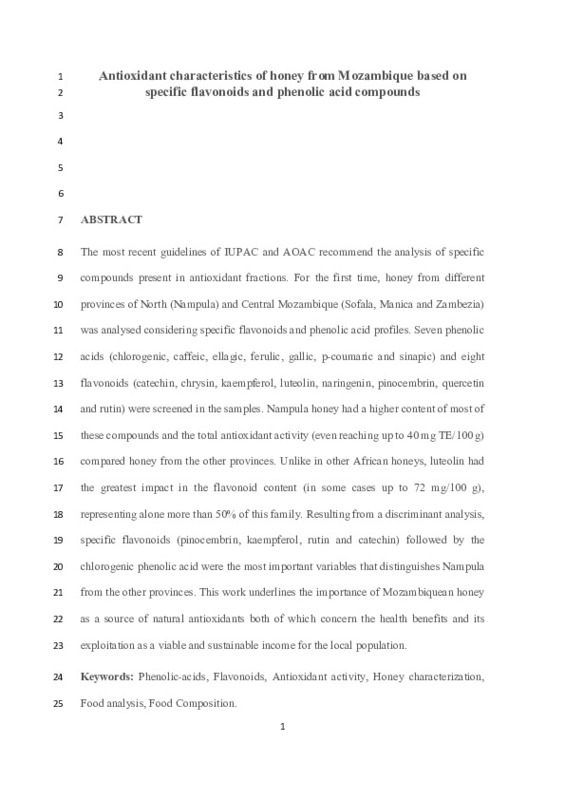JavaScript is disabled for your browser. Some features of this site may not work without it.
Buscar en RiuNet
Listar
Mi cuenta
Estadísticas
Ayuda RiuNet
Admin. UPV
Antioxidant characteristics of honey from Mozambique based on specific flavonoids and phenolic acid compounds
Mostrar el registro sencillo del ítem
Ficheros en el ítem
| dc.contributor.author | Tanleque-Alberto, Fernando-Joao
|
es_ES |
| dc.contributor.author | Juan-Borras, María del Sol
|
es_ES |
| dc.contributor.author | Escriche Roberto, Mª Isabel
|
es_ES |
| dc.date.accessioned | 2023-12-27T19:01:14Z | |
| dc.date.available | 2023-12-27T19:01:14Z | |
| dc.date.issued | 2020-03 | es_ES |
| dc.identifier.issn | 0889-1575 | es_ES |
| dc.identifier.uri | http://hdl.handle.net/10251/201167 | |
| dc.description.abstract | [EN] The most recent guidelines of IUPAC and AOAC recommend the analysis of specific compounds present in antioxidant fractions. For the first time, honey from different provinces of North (Nampula) and Central Mozambique (Sofala, Manica and Zambezia) was analysed considering specific flavonoids and phenolic acid profiles. Seven phenolic acids (chlorogenic, caffeic, ellagic, ferulic, gallic, p-coumaric and sinapic) and eight flavonoids (catechin, chrysin, kaempferol, luteolin, naringenin, pinocembrin, quercetin and rutin) were screened in the samples. Nampula honey had a higher content of most of these compounds and the total antioxidant activity (even reaching up to 40 mg TE/100 g) compared honey from the other provinces. Unlike in other African honeys, luteolin had the greatest impact in the flavonoid content (in some cases up to 72 mg/100 g), representing alone more than 50% of this family. Resulting from a discriminant analysis, specific flavonoids (pinocembrin, kaempferol, rutin and catechin) followed by the chlorogenic phenolic acid were the most important variables that distinguishes Nampula from the other provinces. This work underlines the importance of Mozambiquean honey as a source of natural antioxidants both of which concern the health benefits and its exploitation as a viable and sustainable income for the local population. | es_ES |
| dc.description.sponsorship | The authors thank the Ministerio de Ciencia e Tecnologia Ensino Superior e Tecnico Profissional de Mocambique (Project: HEST "Ensino Superior, Ciencia e Tecnologia") and Universidade Rovuma, Nampula (Mozambique) for the grant awarded to Fernando Tanleque-Alberto. | es_ES |
| dc.language | Inglés | es_ES |
| dc.publisher | Elsevier | es_ES |
| dc.relation.ispartof | Journal of Food Composition and Analysis | es_ES |
| dc.rights | Reconocimiento - No comercial - Sin obra derivada (by-nc-nd) | es_ES |
| dc.subject | Phenolic-acids | es_ES |
| dc.subject | Flavonoids,Antioxidant activity | es_ES |
| dc.subject | Honey characterization | es_ES |
| dc.subject | Food analysis | es_ES |
| dc.subject | Food composition | es_ES |
| dc.subject.classification | TECNOLOGIA DE ALIMENTOS | es_ES |
| dc.title | Antioxidant characteristics of honey from Mozambique based on specific flavonoids and phenolic acid compounds | es_ES |
| dc.type | Artículo | es_ES |
| dc.identifier.doi | 10.1016/j.jfca.2019.103377 | es_ES |
| dc.rights.accessRights | Abierto | es_ES |
| dc.contributor.affiliation | Universitat Politècnica de València. Escuela Técnica Superior de Ingeniería Agronómica y del Medio Natural - Escola Tècnica Superior d'Enginyeria Agronòmica i del Medi Natural | es_ES |
| dc.description.bibliographicCitation | Tanleque-Alberto, F.; Juan-Borras, MDS.; Escriche Roberto, MI. (2020). Antioxidant characteristics of honey from Mozambique based on specific flavonoids and phenolic acid compounds. Journal of Food Composition and Analysis. 86:1-7. https://doi.org/10.1016/j.jfca.2019.103377 | es_ES |
| dc.description.accrualMethod | S | es_ES |
| dc.relation.publisherversion | https://doi.org/10.1016/j.jfca.2019.103377 | es_ES |
| dc.description.upvformatpinicio | 1 | es_ES |
| dc.description.upvformatpfin | 7 | es_ES |
| dc.type.version | info:eu-repo/semantics/publishedVersion | es_ES |
| dc.description.volume | 86 | es_ES |
| dc.relation.pasarela | S\405413 | es_ES |
| dc.contributor.funder | Universidade Rovuma | es_ES |
| dc.contributor.funder | Ministério da Ciência e Tecnologia, Ensino Superior e Técnico Profissional, Mozambique | es_ES |







![[Cerrado]](/themes/UPV/images/candado.png)

